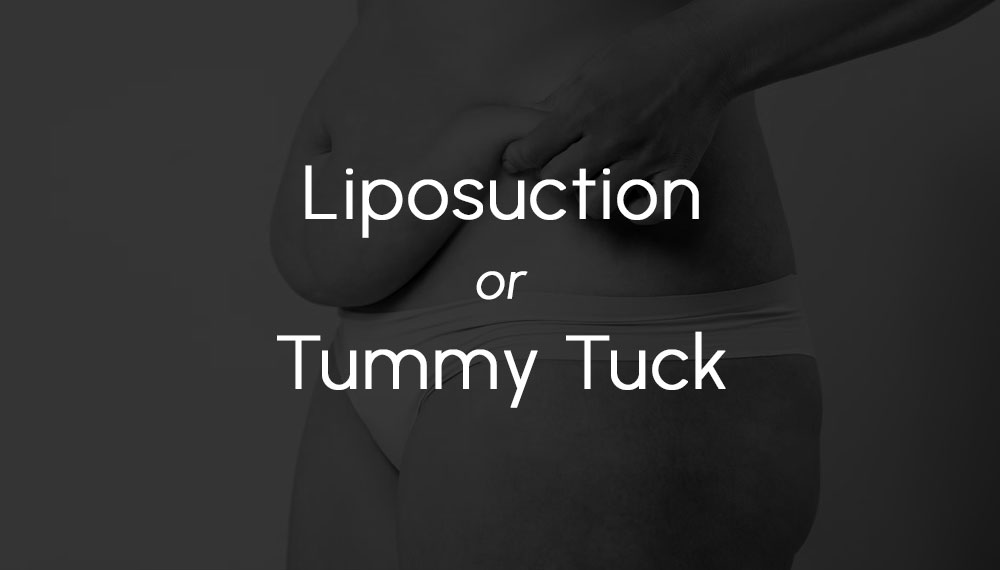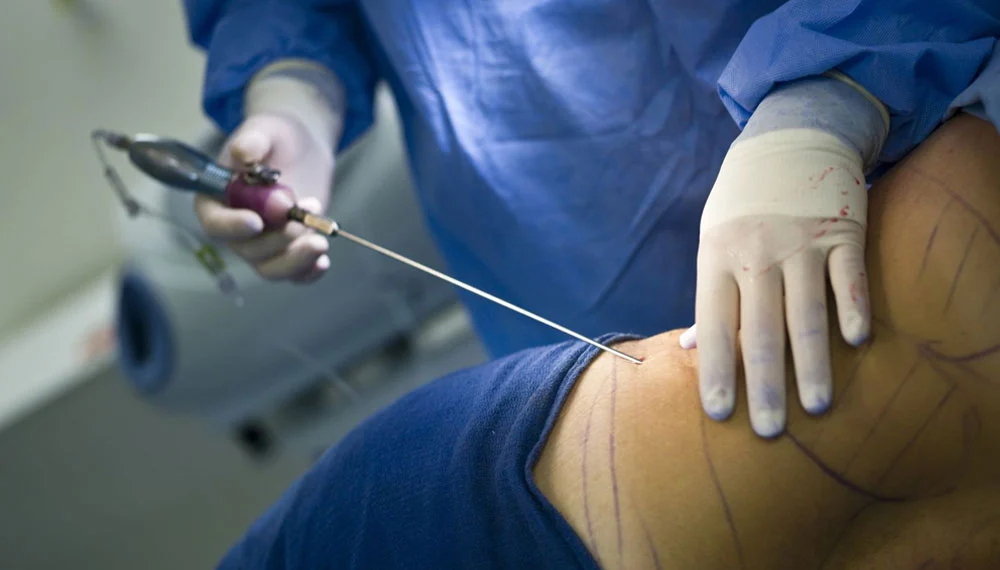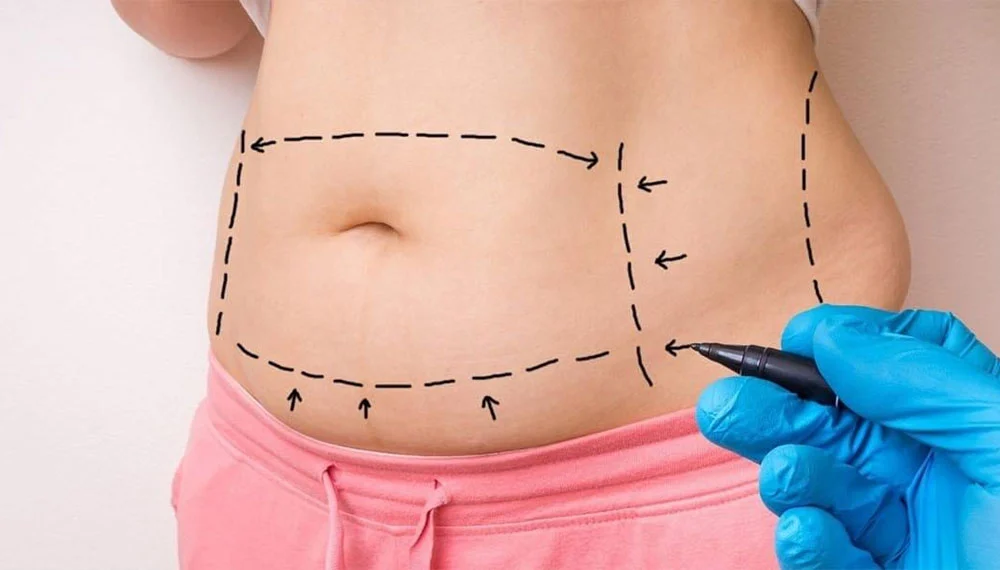
Pondering over the best way to reshape your body can be a personal and sometimes complex decision. In a city like Abu Dhabi, where standards of beauty are diverse, the options for cosmetic enhancement are as varied as the people seeking them. Two popular but very different procedures often in the minds of individuals looking to refine their figures—liposuction and tummy tuck (abdominoplasty).
But how does one decide which surgical path is the right choice? It all starts with understanding the nuances of each procedure and aligning them with your personal aesthetic goals and health considerations.
Before proceeding with any cosmetic surgery, it’s essential to seek consultations with reputable plastic surgeons you’re considering for the procedure. At Elyzee Hospital, we embrace a philosophy of personalized healthcare. We understand the uniqueness of each patient’s anatomy and their specific transformation aspirations, which is at the heart of our approach. In this blog, we’ll explore the fundamental differences between liposuction and tummy tuck, equipping you with the critical insights needed to confidently pursue your aesthetic goals.

Understanding Liposuction
Liposuction, also referred to as lipoplasty or simply lipo, stands as a minimally invasive surgical procedure aimed at eliminating localized fat deposits from various parts of the body. This technique is ideal for those who wish to remove unwanted fat that does not respond to regular diet and exercise. The process involves the use of a thin, hollow tube known as a cannula, which is inserted into the body through small incisions. This cannula is then attached to a powerful suction device. Your surgeon meticulously moves the cannula back and forth to dislodge the fat, which is then vacuumed out from the targeted area. The result is a more sculpted and contoured body appearance, enhancing the patient’s overall body shape and confidence.
It’s essential to note that there are different types of liposuction, each tailored to meet the specific needs and goals of the patient. The choice from these liposuction techniques often depends on the patient’s case and the plastic surgeon’s recommendation.
These variations include tumescent liposuction, ultrasound assisted liposuction (UAL), and laser-assisted liposuction (LAL), among others. Tumescent liposuction involves injecting a medicated solution into the fatty areas before the fat is removed, which helps to minimize blood loss and reduce pain. Ultrasound assisted liposuction (UAL) uses ultrasonic vibrations to liquefy fat cells, making them easier to vacuum out. Laser-assisted liposuction (LAL), on the other hand, utilizes laser energy to break down fat cells. Each of these techniques has its advantages and may be considered by your surgeon to ensure the best outcome for your body contouring goals.
Ideal Candidates for Liposuction Procedure
- Is within 30% of their ideal body weight
- Has firm, elastic skin and good muscle tone
- Has specific areas of fat deposits that do not respond to diet or exercise
Understanding the criteria for ideal candidates for liposuction goes beyond mere physical appearance. From a medical standpoint, the body’s ability to respond to the liposuction surgery and recover effectively plays a crucial role in determining ideal patients to undergo liposuction. Individuals close to their ideal body weight typically have a stable fat composition, ensuring that liposuction can effectively target and reduce unwanted fat pockets. This stability is pivotal for achieving desired aesthetic outcomes.
Furthermore, the requirement for firm, elastic skin and good muscle tone is rooted in the body’s healing capabilities. Post-procedure, the skin needs to retract smoothly over the newly contoured areas. Elasticity in the skin ensures it can adjust to the body’s changed shape, resulting in a more natural, toned appearance. Good muscle tone, in conjunction, supports the underlying structure, providing a solid foundation that enhances the sculptural effects of liposuction.
Lastly, candidates must have localized fat deposits unresponsive to diet and exercise, as liposuction is not a weight-loss solution or an alternative to healthy lifestyle choices. Rather, it is a refinement procedure that contours and defines areas unaffected by traditional weight-loss methods. This distinction is important for setting realistic expectations and achieving patient satisfaction.
Treatable Areas
The diversity in treatable areas for liposuction highlights its versatility as a contouring surgery tailored to individual needs. Each area targeted presents its unique challenges and rewards. Liposuction can be performed on several parts of the body, including:
- Abdomen and waist: Often the most requested area for liposuction, it reshapes what is commonly referred to as the “belly area.” This liposuction procedure can dramatically improve the silhouette of the midsection, offering a more defined waist and flatter stomach.
- Hips and buttocks: Contouring these areas can enhance the natural curves of the body, creating a more balanced and proportionate figure. Liposuction can remove excess fat deposits, highlighting the buttocks’ shape or reducing the width of the hips for a streamlined appearance.
- Thighs: The inner and outer thighs are frequent areas of concern, especially for women. Liposuction can slim down these areas, reducing the rubbing/chafing effect and improving the overall leg contour to fit more comfortably in clothing.
- Upper arms: This area tends to accumulate stubborn fat that can be difficult to eliminate through exercise alone. Liposuction can help achieve a toned look, important for fitting into clothing better and improving self-confidence.
- Back: Fat deposits on the back, including the “bra bulge,” can be effectively treated, offering a smoother back profile and improving the fit and look of clothing.
- Neck and under the chin: Also known as submental liposuction, this aims to remove the double chin, refining the jawline and enhancing the neck’s contour. This small change can have a significant impact on one’s profile and overall facial aesthetics.
- Inner knee: Fat accumulation around the inner knee can be sculpted away to define the knee better and enhance the leg’s shape, making it a subtle yet impactful area for liposuction.
- Chest area: In men, liposuction can reduce enlarged breasts, a condition known as gynecomastia, leading to a more masculine chest contour.
Understanding the specific characteristics and potential results of liposuction in these areas is essential for setting realistic expectations. A meticulous approach tailored to each patient’s body shape and goals ensures that liposuction provides improvements that are both aesthetically pleasing and harmonious with the overall body contour.
Benefits and Limitations of Liposuction
Some benefits of liposuction include:
- Enhanced body contours
- Improved self-image
- Minimal scarring
Despite these enhancements, liposuction has its limitations. Firstly, it’s important to understand that liposuction is not a weight-loss method nor does it address issues like obesity, cellulite, or sagging skin, which might require other procedures or treatments. It is primarily designed for body contouring by removing excess fat deposits.
From a medical perspective, the benefits of liposuction extend to improvements in certain health-related issues. For instance, the removal of fat cells can decrease triglyceride levels in some patients, potentially reducing the risk of heart disease and diabetes. Additionally, eliminating fat in areas like the neck and under the chin can improve breathing issues and reduce symptoms of sleep apnea.
However, the procedure is not without potential complications. These can include infection, bleeding, asymmetry, or changes in skin sensation. Some patients may experience dissatisfaction with the results due to unrealistic expectations or suboptimal skin elasticity, leading to skin dimpling or lumpiness post-surgery. It’s also crucial for patients to maintain stable weight post-procedure, as significant weight gain can alter the results of liposuction, with new fat deposits potentially forming in different areas of the body.
Thus, while liposuction offers noticeable improvements in body contour and can contribute to a better quality of life, candidates must have clear, realistic expectations and be informed about the potential risks and limitations. Engaging with an experienced, board-certified plastic surgeon can help ensure you receive comprehensive advice tailored to your specific health and cosmetic goals.

Understanding Tummy Tuck (Abdominoplasty)
A tummy tuck targets more than just fat—it addresses skin and muscle laxity, creating a flatter, firmer midsection. During a tummy tuck, your surgeon will make an incision, usually from hip to hip, and then work to tighten the abdominal muscles and remove excess skin and fat.
Ideal Candidates for Tummy Tuck
Ideal tummy tuck candidates are generally:
- Those who have lost significant weight or have given birth, leading to stretched skin and weakened muscles
- Not planning on becoming pregnant
- Committed to maintaining a stable weight post-surgery
Ideal candidates for a tummy tuck, or abdominoplasty, often include individuals who have experienced significant physiological changes that diet and exercise alone cannot reverse. This particularly applies to those who have undergone pregnancy, resulting in stretched abdominal muscles and skin. It’s also ideally suited for individuals who have achieved substantial weight loss, but are left with loose, excess skin that fails to conform to their reduced body size.
Additionally, candidates should be in good overall health, non-smokers, or willing to quit smoking well in advance of the surgery, as smoking can significantly impair healing and increase the risk of complications. Importantly, a tummy tuck is best considered when no further pregnancies are planned, as subsequent pregnancies can compromise the surgical results.
Lastly, having realistic expectations about the outcomes of the surgery and understanding that a tummy tuck is not a substitute for weight loss but rather a procedure for contouring and removing excess skin is crucial for patient satisfaction.
Different Types of Tummy Tucks
There are various types of tummy tucks, including:
- Full tummy tuck (standard)
- Mini tummy tuck
- Extended tummy tuck
Full Tummy Tuck (Standard)
A Full Tummy Tuck, or Standard Tummy Tuck, is the most comprehensive form of this cosmetic procedure. It is particularly beneficial for individuals who wish to address excess fat, skin, and laxity of the abdominal wall muscles extending from the lower ribcage to the pubic bone. During this procedure, a horizontal or U-shaped incision is made above the pubic mound, stretching from hip to hip, allowing the surgeon to remove excess skin and fat and to repair and tighten the stretched or separated abdominal muscles (a condition known as diastasis recti). This procedure often includes repositioning the navel to fit the newly shaped abdomen, ensuring a natural-looking outcome. The Full Tummy Tuck is ideal for patients who are looking for major changes in their abdominal area, especially after significant weight loss, pregnancy, or aging.
Mini Tummy Tuck
The Mini Tummy Tuck targets the lower abdomen, specifically beneath the navel. It is a less invasive procedure compared to the Full Tummy Tuck, with a smaller incision and typically followed by a shorter recovery period. This procedure is best suited for individuals who are relatively in shape but possess a “pooch,” slight bulge, or excess skin in the lower abdomen that doesn’t respond to diet or exercise. Unlike the Full Tummy Tuck, the Mini Tummy Tuck usually does not involve repositioning of the navel. Given its targeted approach, it is best for patients who are satisfied with their upper abdominal appearance.
Extended Tummy Tuck
An Extended Tummy Tuck goes beyond the standard tummy tuck by addressing excess skin and fat around the sides of the abdomen and the lower back, often resulting in a significantly more pronounced change in body contour. This procedure is particularly useful for individuals who have lost a massive amount of weight and have excess skin hanging around their hips and sides. The incision extends around the flanks to the lower back, which allows for a greater amount of skin and fat to be removed. The Extended Tummy Tuck not only tightens the abdominal area but also contours the waistline and upper lateral thigh. It is the most extensive tummy tuck procedure and requires the longest recovery time.
Insights for Aspiring Patients
For individuals considering a tummy tuck, it’s important to have a thorough consultation with a board-certified plastic surgeon to determine the most appropriate type of tummy tuck based on your body type and cosmetic goals. Discussing your medical history, expectations, and lifestyle will help your surgeon recommend the best approach. It’s also crucial to understand the recovery process, as it can vary significantly between the different types of tummy tucks. Patients should be prepared for downtime, follow post-operative care instructions carefully, and have realistic expectations regarding scarring and results.
Remember, a tummy tuck is not a substitute for weight loss or an appropriate exercise program. Maintaining results with a healthy lifestyle is key to enjoying long-term benefits from your procedure.
Benefits and Limitations of Tummy Tuck
While a tummy tuck can offer transformative results, enhancing the appearance and self-esteem of patients, it’s essential to approach this decision with a comprehensive understanding of both its benefits and limitations. A tummy tuck offers several benefits:
- A tighter, flatter abdominal profile
- Removal of stretch marks—especially in the lower abdomen
- Boosted self-confidence
Further Benefits
In addition to creating a tighter, flatter abdomen and removing stretch marks located below the navel, a tummy tuck can also positively impact one’s posture. By tightening weak abdominal muscles, patients often find improved support for the spine, which can alleviate certain types of back pain. Furthermore, the removal of excess skin and fat can make physical activity more comfortable, encouraging a healthier lifestyle post-surgery.
Limitations
However, there are important limitations and considerations prospective patients must be aware of. A tummy tuck is a major surgical procedure that requires a significant recovery period. Patients typically experience discomfort, swelling, and a temporary disruption in their daily activities, including time off work and a pause in physical exercise. Scarring is also inevitable, though skilled surgeons strategically place incisions to minimize visible scars, and these typically fade over time.
Considerations
While a tummy tuck can offer long-lasting outcomes, significant fluctuations in weight, aging, and future pregnancies can alter the appearance of the abdomen. Therefore, maintaining a stable weight and healthy lifestyle is critical for sustaining results.
Lastly, a tummy tuck should not be seen as a primary weight loss solution. Ideal candidates are those who are already close to their desired weight but are looking to refine and contour their abdominal area.
Understanding these benefits and limitations is crucial for setting realistic expectations and achieving satisfaction with the results. Always ensure that your surgeon is board-certified and that you have thoroughly discussed all aspects of the procedure, recovery, and expected outcomes during your consultation.

Comparing Liposuction and Tummy Tuck
When it comes down to a choice between liposuction and a tummy tuck, it’s important to understand the core differences that make each procedure unique.
Body Type and Treatment Goals
Liposuction is an optimal choice for individuals who struggle with localized fat deposits that stubbornly resist diet and exercise efforts. This procedure can precisely target and remove fat from specific areas, offering a solution when traditional weight loss methods fail to produce results.
On the other hand, a tummy tuck, or abdominoplasty, is best suited for those dealing with loose, excess skin or weakened abdominal muscles. This condition is often the aftermath of significant body changes such as pregnancy or major weight loss. A tummy tuck not only removes the excess skin but also tightens the muscles in the abdomen, providing a more toned and contoured appearance.
Recovery Time
Tummy tucks typically necessitate a longer recovery period. This is largely due to the complexity of the surgery which involves the removal of excess skin and fat, as well as the tightening of abdominal muscles. Such extensive procedures mean that patients need ample time to heal properly.
On the other hand, liposuction, which focuses on removing fat from specific areas of the body through small incisions, is considered less invasive. As a result, liposuction patients often experience a significantly shorter recovery time, allowing them to return to their daily activities more quickly.
Scarring
While both the tummy tuck and liposuction procedures inevitably lead to some degree of scarring, the nature and extent of the scars vary significantly between the two. The incision made during a tummy tuck is generally more extensive, as it often runs from hip to hip just above the pubic area. This results in a longer, more noticeable scar than the one left by liposuction, which typically involves smaller incisions used to insert a cannula for fat removal.
Consequently, those undergoing a tummy tuck should be prepared for a more visible scar, although it’s usually located in an area that can be concealed under clothing.
Preparing for Liposuction or Tummy Tuck
Once you’ve decided on a procedure with the guidance of your surgeon, preparing for your surgery will involve several steps.
Pre-Operative Preparation
Your surgeon will provide detailed instructions on preparing for your procedure, which may include:
- Adjusting current medications
- Refraining from smoking or alcohol consumption
- Arranging for a responsible adult to accompany you on the day of surgery and stay with you during the initial recovery period
Surgery Day Expectations
On the day of your surgery, you can expect:
- The procedure to be performed under either local or general anesthesia, based on the discussed plan
- To be in a recovery room for observation for a few hours after the surgery
- To wear compression garments to help with healing and reduce swelling
Risks and Complications
Both liposuction and tummy tucks, like any surgery, carry a degree of risk. It is essential to discuss these with your surgeon, who can provide information on potential complications and how they would be managed.
Post-Procedure Care and Recovery
The success of your procedure and the quality of your results hinge significantly on your post-operative care.
Post-Operative Instructions
Your surgeon will provide specific post-operative care guidelines, including:
- How to care for your incisions
- When to resume normal activities and exercise
- The importance of wearing compression garments
Managing Pain and Discomfort
Pain is a natural part of the recovery process, and your surgeon may prescribe pain medications to manage your comfort levels.
Follow-Up Appointments
Regular follow-up appointments are critical to monitor your recovery. These will provide an opportunity for your surgeon to assess your progress and address any concerns you may have.
Results and Maintenance
Understanding what to expect from your results and how to maintain them long-term is an essential consideration.
Expected Results
Liposuction and tummy tucks are cosmetic procedures designed to enhance your body’s shape by removing excess fat and skin, leading to significant improvements in body contours and self-image. While individual results can vary greatly depending on a variety of factors, these procedures can dramatically change one’s appearance and boost confidence. It’s important to note that it may take several months for the swelling to fully subside and for the final results to become apparent, as the body needs time to adjust and heal from these surgical interventions.
Maintenance
Maintaining your results will require a commitment to a healthy lifestyle, including eating a balanced diet and regular exercise. While the removed fat cells will not return, remaining fat cells can still enlarge. Similarly, the longevity of tummy tuck results is affected by factors such as weight fluctuation and pregnancy.
Is Tummy Tuck or Liposuction Permanent?
The permanence of tummy tuck and liposuction results is a common concern for many considering these procedures. Generally, the outcomes of both surgeries can be long-lasting, provided patients maintain a stable weight and adhere to a healthy lifestyle. Liposuction permanently removes fat cells from the treated area, which means these cells cannot regrow or replenish. However, it is crucial to note that the remaining fat cells in the body can still expand if one gains weight, potentially altering the sculpted appearance achieved through the procedure.
Similarly, the effects of a tummy tuck, which include tightened abdominal muscles and removal of excess skin, can endure as long as the patient does not experience significant weight fluctuations or undergo subsequent pregnancies, which could stretch out the skin and muscles once more. Therefore, while both procedures offer potentially permanent improvements, the key to preserving these results lies in the patient’s commitment to a healthy and active lifestyle post-surgery.
What Cosmetic Procedure is Right For You?
Choosing between plastic surgery procedures like liposuction and a tummy tuck—or deciding to undergo both—depends significantly on individual needs, body type, and desired outcomes. Liposuction is primarily suited for removing localized fat deposits for those with good skin elasticity, whereas a tummy tuck addresses loose skin and weakened abdominal muscles, often providing more dramatic changes for patients post-pregnancy or those who have experienced significant weight loss. Both procedures require a thorough understanding of the recovery process, risks, and the need for a stable weight post-surgery to maintain results.
For aspiring patients, it’s crucial to have realistic expectations and to understand that these procedures are not substitutes for weight loss but rather contouring methods that refine the body’s shape. A commitment to a healthy lifestyle post-surgery is essential for sustaining your investment in your body. Consulting with a board-certified surgeon, who can offer personalized advice and direction, is the best way to determine which procedure—or combination of procedures—will meet your goals. Always discuss the potential risks, recovery expectations, and how to prepare for your surgery to ensure the safest and most satisfying outcomes. Remember, the quality of your results depends not only on the skill of your surgeon but also on your adherence to pre- and post-operative care instructions and your commitment to maintaining a healthy lifestyle.
About Elyzee Hospital
Elyzee Hospital stands out as a premier boutique plastic surgery hospital located in the heart of the UAE, and it has rapidly become a leading destination for cosmetic plastic surgery in Abu Dhabi. Our facility is renowned for hosting a team of internationally trained plastic surgeons, along with highly skilled staff, all dedicated to achieving perfection in the field of cosmetic plastic surgery. We pride ourselves on offering a luxury patient experience unmatched in the region, coupled with unparalleled patient care.
Our commitment extends beyond just performing procedures; we aim to deliver excellence throughout the entire journey of cosmetic enhancement. From the initial consultation where we carefully listen to your aspirations and concerns, to the meticulous planning of your procedure, and through to the comprehensive aftercare during your recovery – our focus is steadfastly on meeting your unique needs. Our goal is to provide results that not only enhance your natural beauty but do so in a way that feels authentic to you.
At Elyzee Hospital, we understand that deciding to undergo cosmetic plastic surgery is a significant and deeply personal decision. This is why we ensure that from the moment you step into our hospital for your first consultation, to each follow-up visit after your procedure, you feel supported, informed, and confident in the choices you are making. We are here to guide you through each step, ensuring that your experience is as seamless and comfortable as possible, and that the outcomes exceed your expectations, leaving you feeling more confident and revitalized.
Book A Consultation
At Elyzee Hospital, our experts are committed to helping you achieve your aesthetic goals with liposuction or tummy tuck techniques.
Choosing the right surgeon is vital. During your consultation, you’ll have the opportunity to discuss your goals and explore the best liposuction or tummy tuck options for you. Your health and satisfaction are our priorities, and we’re here to support you at every step.
Schedule your consultation now to discover the right procedure for you. Contact us at 8005005 or visit our contact page.
